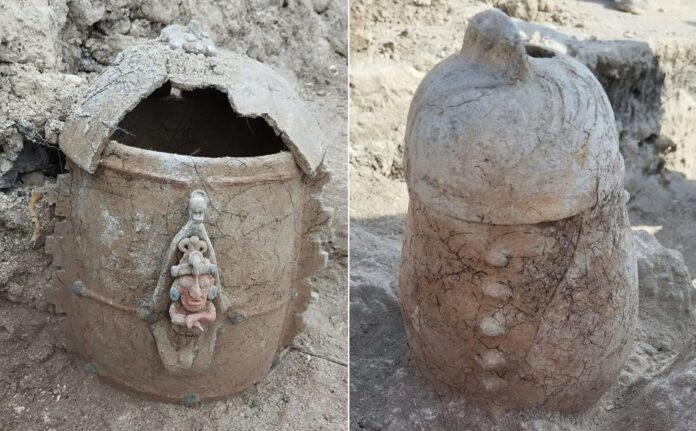Unearthing History: INAH’s Archaeological Triumph

In a fascinating development along the construction path of the Maya Train, archaeologists from the National Institute of Anthropology and History (INAH) have made a significant discovery. During salvage work on section 7 of the train route, they unearthed a funerary urn bearing the carved image of the Maya corn god, offering a glimpse into the rich cultural heritage of the ancient Maya civilization.
The Paaktzatz Urn: A Window into Maya Beliefs

INAH’s general director, Diego Prieto Hernández, identified the vessel as a Paaktzatz-style urn, notable for its distinct portrayal of the corn deity. “The urn presents a very interesting image of the corn god emerging from the leaves of a cob,” Hernández explained. This finding, along with a similar vessel discovered nearby, suggests the presence of an ancient offering site.
Intricate Symbolism: Decoding the Urn’s Artwork

The urn’s design is rich with symbolism. An anthropomorphic pastillage figure on the front depicts the corn god in its growth stage, while the lid features an owl motif – a creature associated with omens and warfare in Classic Maya iconography. The vessel also incorporates the Maya “ik” symbol, representing wind and divine breath, further emphasizing its spiritual significance.
Contextualizing the Discovery
A Broader Archaeological Tapestry
This remarkable find is part of a larger archaeological effort along the Maya Train route. As of January 8, work on sections 5, 6, and 7 had yielded impressive results:
- 40,000 archaeological sites uncovered and protected
- 1,000 artifacts discovered
- Over 200,000 ceramic fragments collected
- 148 human burials identified
Historical Connections
The archaeologists drew parallels between the corn god image on the urn and similar depictions found in figurines from Jaina Island in Campeche. They also noted that Paaktzatz vessels from the Río Bec region, dating between 680 and 770 A.D., provide context for understanding the owl symbolism on the urn’s lid.
Preserving Maya Heritage

This discovery not only sheds light on ancient Maya religious beliefs and artistic practices but also underscores the importance of careful archaeological work in infrastructure projects. As the Maya Train project progresses, it continues to unveil treasures that enrich our understanding of Mesoamerica’s vibrant past, ensuring that the region’s cultural heritage is preserved for future generations.

